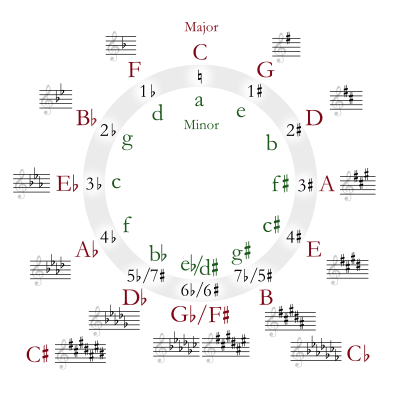A circle of fifths (CoF) progression is one that includes chords whose roots move up or down by 5ths. Dm Am Em Bdim, for example, is an ascending CoF progression. You can hear that there’s a pleasant sense of predictability that results from this kind of progression.
There are many ways to use the CoF, including its use as a memory aid for learning key signatures:

In that rendering of the CoF, it accommodates all 12 semitones within an octave.
But in songwriting, you’re more likely to stick to the notes of the key you’ve chosen. You’re not often, for example, going to use an F# chord in your song if it’s in C major. There is a way to use the CoF in a way that allows you to stick to chords from your song’s key.
 It’s time to get serious about your songwriting. Get “The Essential Secrets of Songwriting” eBook Bundle packages, written by Gary Ewer, includes “From Amateur to Ace – Writing Songs Like a Pro.” Time to become the best songwriter you can be! Read more..
It’s time to get serious about your songwriting. Get “The Essential Secrets of Songwriting” eBook Bundle packages, written by Gary Ewer, includes “From Amateur to Ace – Writing Songs Like a Pro.” Time to become the best songwriter you can be! Read more..
Let’s use the key of C major as our demonstration of how to use CoF to create progressions. First, there are 7 chords that naturally exist in the key of C major. You find them by building triads (simple 3-note chords) above each note of the scale, and you get the following:
C Dm Em F G Am Bdim
(If you find this stage of creating chords difficult, someone has already gone to the trouble of generating chord lists, which you can see here.)
Those are the chords you’ll be using when you create your CofF progression. If you were to start on the C chord, an ascending CoF progression would look like this:
C G Dm Am Em Bdim F C
In an ascending CoF progression, the Bdim is tricky because, when it’s followed by F, the interval between B and F is a diminished 5th – a difficult interval to use.
So what’s a more relevant and satisfying way to use the circle? It’s this:
- Start on the tonic chord (C)
- Choose any note you wish to be your 2nd chord (Dm, for example).
- Begin moving by 5ths for a few chords (C Dm Am Em…)
- Jump out of the CoF and “find a way home” (C Dm Am Em F G C)
As you can see, the CoF is used as the main middle part of the progression, and strengthens the entire progression. Of course, you can start right away with the circle by moving up by fifths immediately after the C, giving you this: C G Dm Am Em…
Perhaps a more satisfying way to use the CoF is by moving down by 5ths, and that’s where Bdim sounds easier: C F Bdim Em Am Dm G C.
And of course, it doesn’t matter which key you use for your song. In that regard, Roman numerals will show you how it all works:
I IV vii iii vi ii V I
Getting Creative: Changing Chords Within the Circle
One way to use the circle creatively is to change the quality (major/minor) of the chord. For example, change the Em to E7, and you get this:
C F Bdim E7 Am
You can also add a 7th to the I-chord, creating a pleasant secondary dominant sound:
C7 F Bdim…
Remember, using a CoF doesn’t mean that you must stick with it for your entire progression. Use it for as long as you want, and then find a “jumping out” point.
To show this, here’s a list of progressions you can use, all of which use the CoF to a certain extent, and then jump away from it to end. The trick CoF is shown in bold print:
- C F Bdim Em Am G7 C
- C Am Em Bdim Am F G C
- C F G Em Am Em F C
- Am Dm G C F Dm G C
- F G C F Bdim Em Am G
Using Circle of Fifths in a Minor Key
Yes, it works in minor as well, as you hear in Train’s “50 Ways to Say Goodbye”: D#m G#m C# F# B G#m A#sus4 A#. They abandon the CoF after the B chord:
Songs in minor keys often make quick visits to the relative major, so minor key CoF can give you many interesting possibilities. To create a minor key CoF, here’s one possibility: choose from the following: Cm Ddim Eb Fm G Ab Bb
That gives you this as a possible minor CoF:
Cm Fm Bb Eb Ab Ddim Gsus4 G
 Written by Gary Ewer. Follow on Twitter.
Written by Gary Ewer. Follow on Twitter.
 “The Essential Secrets of Songwriting” eBook Bundle packages look at songwriting from every angle, and have been used by thousands of songwriters. How to use chords, write melodies, and craft winning lyrics. Take advantage of today’s Deluxe Bundle DISCOUNT. Read more..
“The Essential Secrets of Songwriting” eBook Bundle packages look at songwriting from every angle, and have been used by thousands of songwriters. How to use chords, write melodies, and craft winning lyrics. Take advantage of today’s Deluxe Bundle DISCOUNT. Read more..











Pingback: Choosing the Chords That Work With Your Melody | The Essential Secrets of Songwriting
Pingback: Why Wheels Circle? | One Minute Song